Service KIA Borrego 2009 1.G Owner's Guide
[x] Cancel search | Manufacturer: KIA, Model Year: 2009, Model line: Borrego, Model: KIA Borrego 2009 1.GPages: 425, PDF Size: 8.46 MB
Page 350 of 425
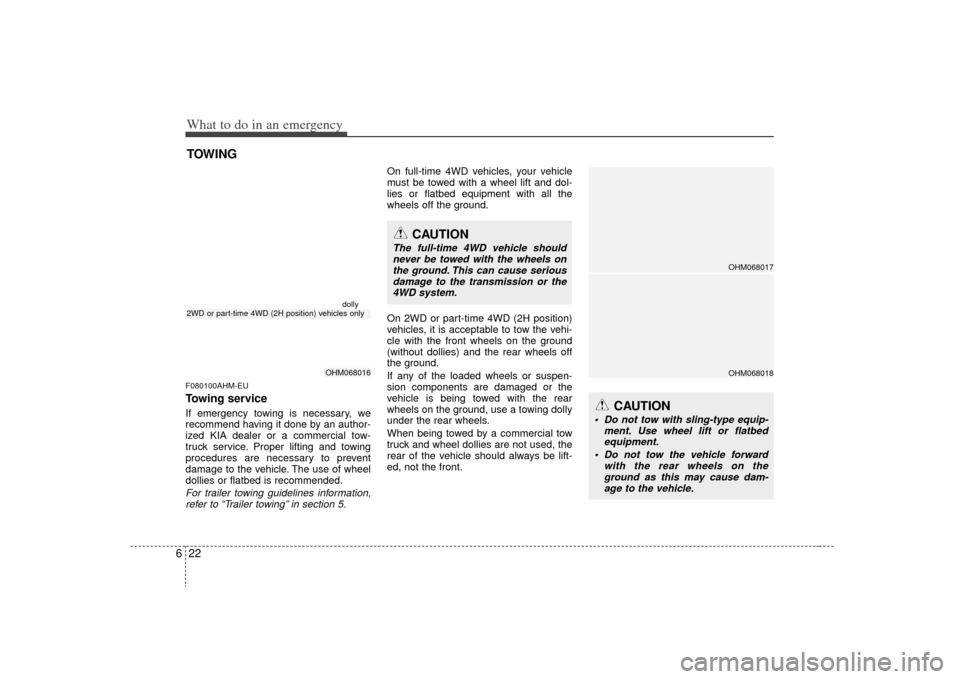
What to do in an emergency22
6TOWINGF080100AHM-EUTowing serviceIf emergency towing is necessary, we
recommend having it done by an author-
ized KIA dealer or a commercial tow-
truck service. Proper lifting and towing
procedures are necessary to prevent
damage to the vehicle. The use of wheel
dollies or flatbed is recommended.For trailer towing guidelines information,
refer to “Trailer towing” in section 5.
On full-time 4WD vehicles, your vehicle
must be towed with a wheel lift and dol-
lies or flatbed equipment with all the
wheels off the ground.
On 2WD or part-time 4WD (2H position)
vehicles, it is acceptable to tow the vehi-
cle with the front wheels on the ground
(without dollies) and the rear wheels off
the ground.
If any of the loaded wheels or suspen-
sion components are damaged or the
vehicle is being towed with the rear
wheels on the ground, use a towing dolly
under the rear wheels.
When being towed by a commercial tow
truck and wheel dollies are not used, the
rear of the vehicle should always be lift-
ed, not the front.
OHM068016 dolly
2WD or part-time 4WD (2H position) vehicles only
OHM068017
CAUTION
The full-time 4WD vehicle should
never be towed with the wheels onthe ground. This can cause serious damage to the transmission or the4WD system.
CAUTION
Do not tow with sling-type equip- ment. Use wheel lift or flatbedequipment.
Do not tow the vehicle forward with the rear wheels on theground as this may cause dam-age to the vehicle.
OHM068018
Page 351 of 425
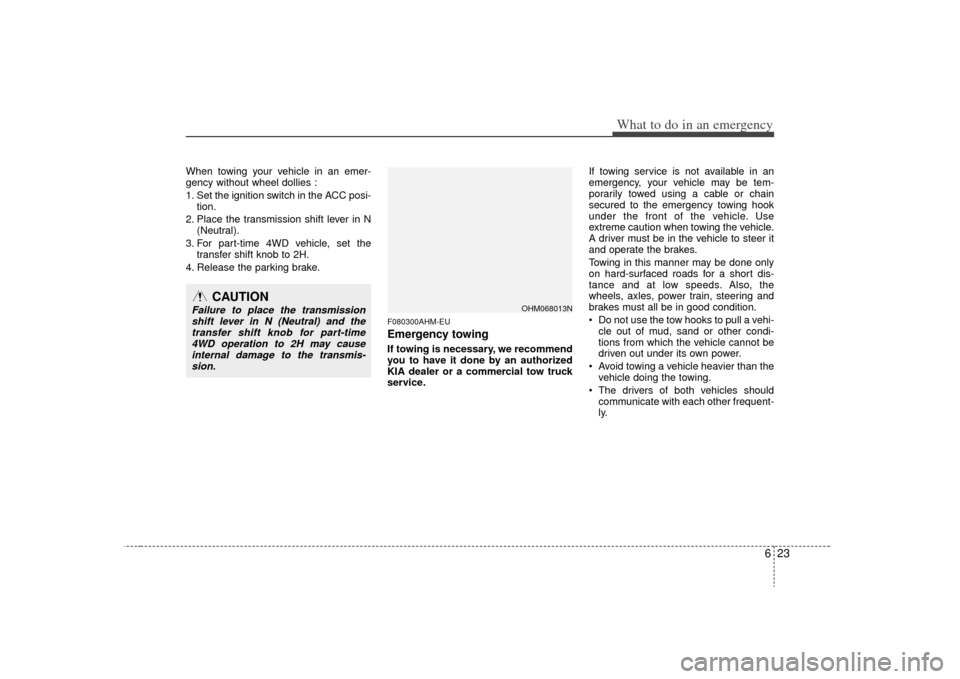
623
What to do in an emergency
When towing your vehicle in an emer-
gency without wheel dollies :
1. Set the ignition switch in the ACC posi-tion.
2. Place the transmission shift lever in N (Neutral).
3. For part-time 4WD vehicle, set the transfer shift knob to 2H.
4. Release the parking brake.
F080300AHM-EUEmergency towingIf towing is necessary, we recommend
you to have it done by an authorized
KIA dealer or a commercial tow truck
service. If towing service is not available in an
emergency, your vehicle may be tem-
porarily towed using a cable or chain
secured to the emergency towing hook
under the front of the vehicle. Use
extreme caution when towing the vehicle.
A driver must be in the vehicle to steer it
and operate the brakes.
Towing in this manner may be done only
on hard-surfaced roads for a short dis-
tance and at low speeds. Also, the
wheels, axles, power train, steering and
brakes must all be in good condition.
Do not use the tow hooks to pull a vehi-
cle out of mud, sand or other condi-
tions from which the vehicle cannot be
driven out under its own power.
Avoid towing a vehicle heavier than the vehicle doing the towing.
The drivers of both vehicles should communicate with each other frequent-
ly.
OHM068013N
CAUTION
Failure to place the transmissionshift lever in N (Neutral) and thetransfer shift knob for part-time 4WD operation to 2H may causeinternal damage to the transmis-sion.
Page 352 of 425

What to do in an emergency24
6 Before emergency towing, check that
the hook is not broken or damaged.
Fasten the towing cable or chain securely to the hook.
Do not jerk the hook. Apply it steadily and with even force.
To avoid damaging the hook, do not pull from the side or at a vertical angle.
Always pull straight ahead. Use a towing strap less than 5 m (16
feet) long. Attach a white or red cloth
(about 30 cm (12 inches) wide) in the
middle of the strap for easy visibility.
Drive carefully so that the towing strap is not loose during towing.
WARNING
Use extreme caution when towing
the vehicle.
driving maneuvers which would
place excessive stress on the
emergency towing hook and tow-
ing cable or chain. The hook and
towing cable or chain may break
and cause serious injury or dam-
age.
If the disabled vehicle cannot be moved, do not forcibly continue
the towing. Contact an authorized
KIA dealer or a commercial tow
truck service for assistance.
Tow the vehicle as straight ahead as possible.
Keep away from the vehicle dur- ing towing.
CAUTION
Attach a towing strap to the tow hook.
Using a portion of the vehicle other than the tow hooks for tow-ing may damage the body of your vehicle.
Only use a cable or chain specifi- cally intended for use in towingvehicles. Securely fasten thecable or chain to the towing hook provided.
OHM068019
Page 354 of 425
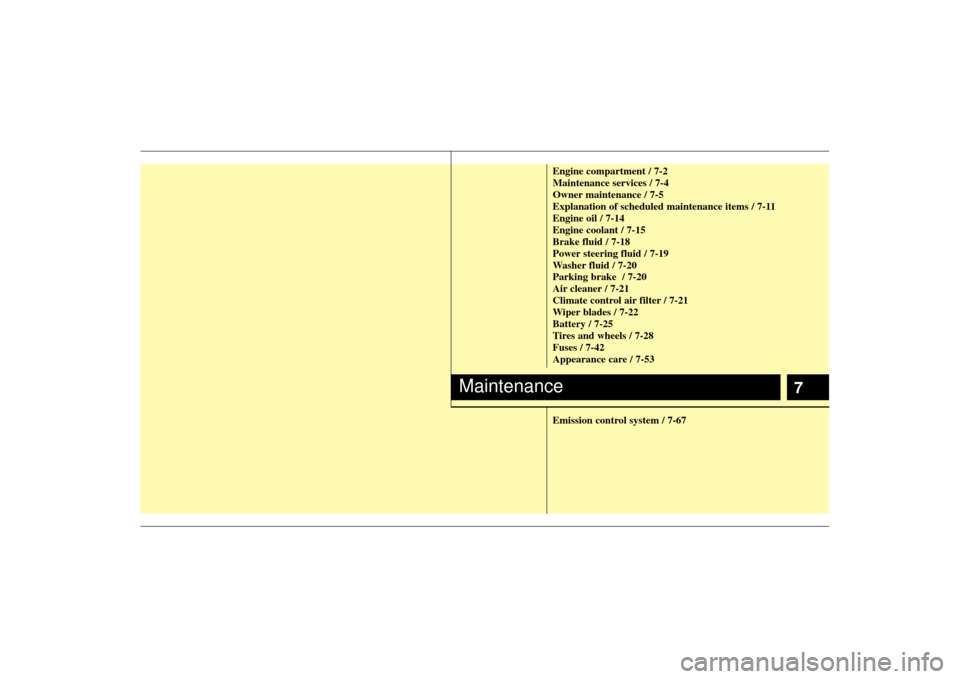
7
Engine compartment / 7-2
Maintenance services / 7-4
Owner maintenance / 7-5
Explanation of scheduled maintenance items / 7-11
Engine oil / 7-14
Engine coolant / 7-15
Brake fluid / 7-18
Power steering fluid / 7-19
Washer fluid / 7-20
Parking brake / 7-20
Air cleaner / 7-21
Climate control air filter / 7-21
Wiper blades / 7-22
Battery / 7-25
Tires and wheels / 7-28
Fuses / 7-42
Appearance care / 7-53
Emission control system / 7-67
Maintenance
Page 357 of 425
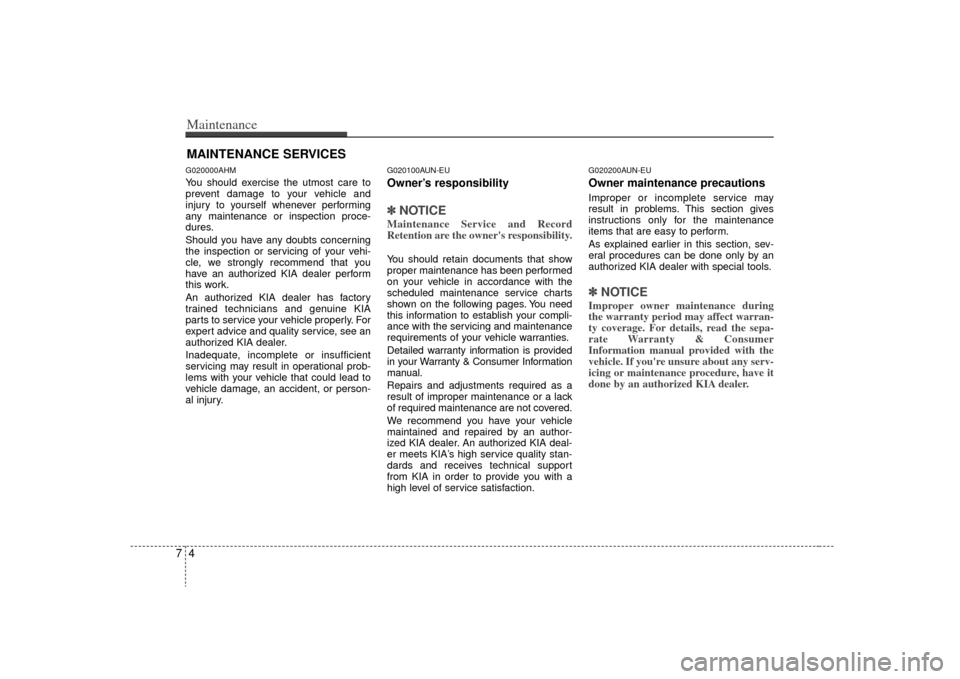
Maintenance47MAINTENANCE SERVICESG020000AHMYou should exercise the utmost care to
prevent damage to your vehicle and
injury to yourself whenever performing
any maintenance or inspection proce-
dures.
Should you have any doubts concerning
the inspection or servicing of your vehi-
cle, we strongly recommend that you
have an authorized KIA dealer perform
this work.
An authorized KIA dealer has factory
trained technicians and genuine KIA
parts to service your vehicle properly. For
expert advice and quality service, see an
authorized KIA dealer.
Inadequate, incomplete or insufficient
servicing may result in operational prob-
lems with your vehicle that could lead to
vehicle damage, an accident, or person-
al injury.
G020100AUN-EUOwner’s responsibility ✽ ✽NOTICEMaintenance Service and Record
Retention are the owner's responsibility. You should retain documents that show
proper maintenance has been performed
on your vehicle in accordance with the
scheduled maintenance service charts
shown on the following pages. You need
this information to establish your compli-
ance with the servicing and maintenance
requirements of your vehicle warranties.
Detailed warranty information is provided
in your Warranty & Consumer Information
manual.
Repairs and adjustments required as a
result of improper maintenance or a lack
of required maintenance are not covered.
We recommend you have your vehicle
maintained and repaired by an author-
ized KIA dealer. An authorized KIA deal-
er meets KIA’s high service quality stan-
dards and receives technical support
from KIA in order to provide you with a
high level of service satisfaction.
G020200AUN-EUOwner maintenance precautions Improper or incomplete service may
result in problems. This section gives
instructions only for the maintenance
items that are easy to perform.
As explained earlier in this section, sev-
eral procedures can be done only by an
authorized KIA dealer with special tools.✽ ✽NOTICEImproper owner maintenance during
the warranty period may affect warran-
ty coverage. For details, read the sepa-
rate Warranty & Consumer
Information manual provided with the
vehicle. If you're unsure about any serv-
icing or maintenance procedure, have it
done by an authorized KIA dealer.
Page 378 of 425
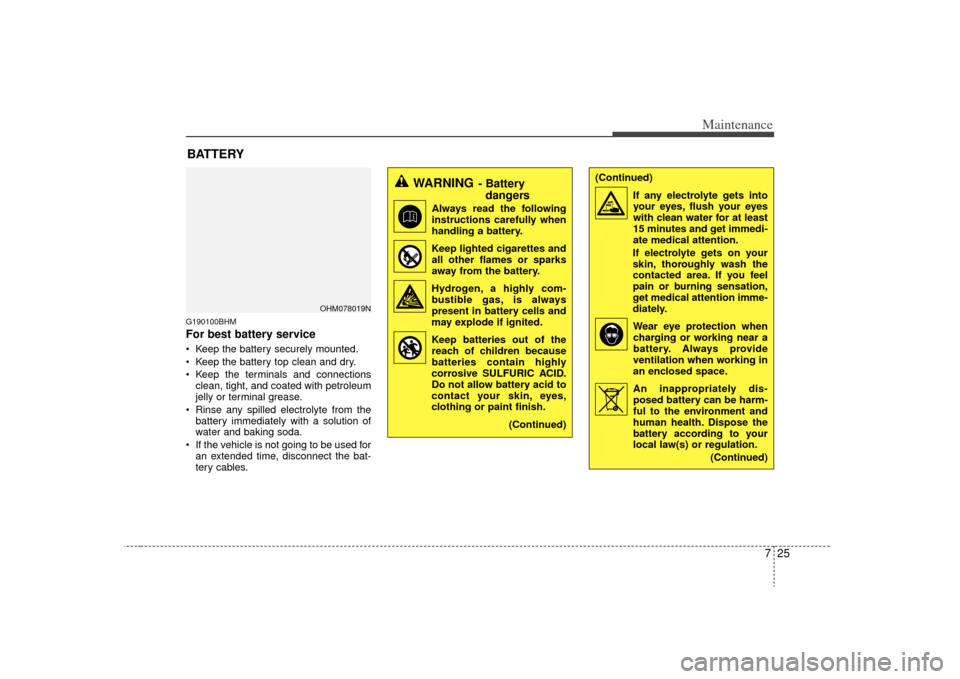
725
Maintenance
BATTERYG190100BHMFor best battery service Keep the battery securely mounted.
Keep the battery top clean and dry.
Keep the terminals and connectionsclean, tight, and coated with petroleum
jelly or terminal grease.
Rinse any spilled electrolyte from the battery immediately with a solution of
water and baking soda.
If the vehicle is not going to be used for an extended time, disconnect the bat-
tery cables.
OHM078019N
WARNING
- Battery dangers
Always read the following
instructions carefully when
handling a battery.
Keep lighted cigarettes and all other flames or sparks
away from the battery.
Hydrogen, a highly com- bustible gas, is always
present in battery cells and
may explode if ignited.
Keep batteries out of the reach of children because
batteries contain highly
corrosive SULFURIC ACID.
Do not allow battery acid to
contact your skin, eyes,
clothing or paint finish.
(Continued)
(Continued)If any electrolyte gets intoyour eyes, flush your eyes
with clean water for at least
15 minutes and get immedi-
ate medical attention.
If electrolyte gets on your
skin, thoroughly wash the
contacted area. If you feel
pain or burning sensation,
get medical attention imme-
diately.
Wear eye protection whencharging or working near a
battery. Always provide
ventilation when working in
an enclosed space.
An inappropriately dis- posed battery can be harm-
ful to the environment and
human health. Dispose the
battery according to your
local law(s) or regulation.
(Continued)
Page 388 of 425

735
Maintenance
Tire speed ratings The chart below lists many of the dif-
ferent speed ratings currently being
used for passenger car tires. The
speed rating is part of the tire size
designation on the sidewall of the
tire. This symbol corresponds to that
tire's designed maximum safe oper-
ating speed.
G201003AHM3. Checking tire life (TIN : TireIdentification Number) Any tires that are over 6 years old,
based on the manufacturing date,
(including the spare tire) should be
replaced by new ones. You can find
the manufacturing date on the tire
sidewall (possibly on the inside of the
wheel), displaying the DOT Code.
The DOT Code is a series of num-
bers on a tire consisting of numbers
and English letters. The manufactur-
ing date is designated by the last four
digits (characters) of the DOT code.
DOT : XXXX XXXX OOOO
The front part of the DOT means a
plant code number, tire size and
tread pattern and the last four num-
bers indicate week and year manu-
factured.
For example:
DOT XXXX XXXX 1608 represents
that the tire was produced in the 16th
week of 2008.
WARNING
- Tire age
Tires degrade over time, even
when they are not being used.
Regardless of the remaining
tread, we recommend that tires
be replaced after approximately
six (6) years of normal service.
Heat caused by hot climates or
frequent high loading condi-
tions can accelerate the aging
process. Failure to follow this
warning can result in sudden
tire failure, which could lead to
a loss of control and an acci-
dent involving serious injury or
death.
S 180 km/h (112 mph)
T 190 km/h (118 mph)
H 210 km/h (130 mph) V 240 km/h (149 mph)Z Above 240 km/h (149 mph)
Maximum Speed
Speed
Rating
Symbol
Page 389 of 425
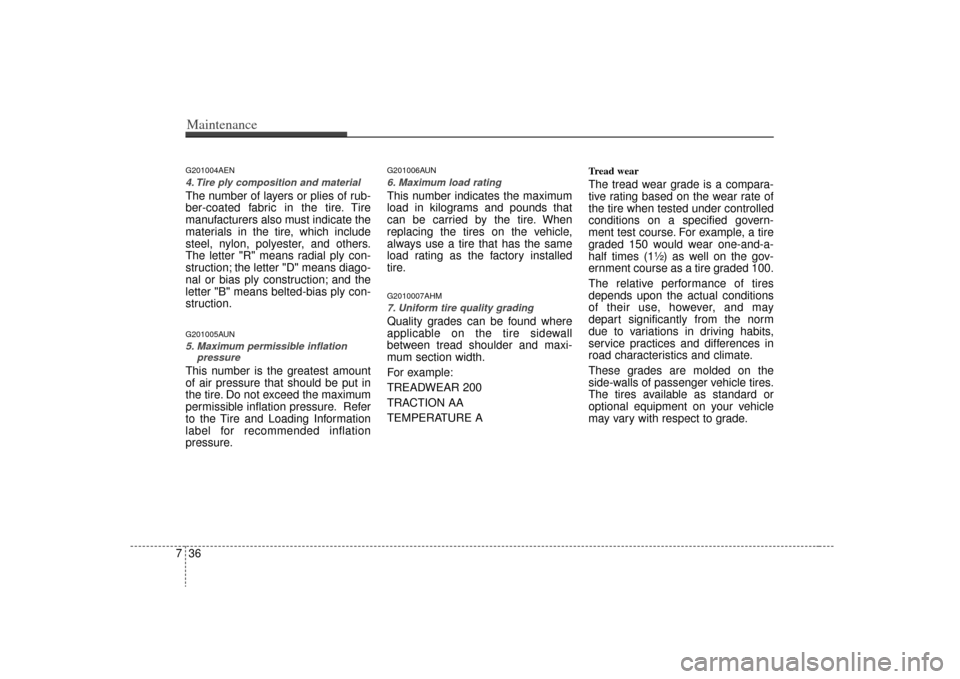
Maintenance36
7G201004AEN4. Tire ply composition and materialThe number of layers or plies of rub-
ber-coated fabric in the tire. Tire
manufacturers also must indicate the
materials in the tire, which include
steel, nylon, polyester, and others.
The letter "R" means radial ply con-
struction; the letter "D" means diago-
nal or bias ply construction; and the
letter "B" means belted-bias ply con-
struction.G201005AUN5. Maximum permissible inflation
pressureThis number is the greatest amount
of air pressure that should be put in
the tire. Do not exceed the maximum
permissible inflation pressure. Refer
to the Tire and Loading Information
label for recommended inflation
pressure.
G201006AUN6. Maximum load ratingThis number indicates the maximum
load in kilograms and pounds that
can be carried by the tire. When
replacing the tires on the vehicle,
always use a tire that has the same
load rating as the factory installed
tire.G2010007AHM7. Uniform tire quality gradingQuality grades can be found where
applicable on the tire sidewall
between tread shoulder and maxi-
mum section width.
For example:
TREADWEAR 200
TRACTION AA
TEMPERATURE A
Tread wearThe tread wear grade is a compara-
tive rating based on the wear rate of
the tire when tested under controlled
conditions on a specified govern-
ment test course. For example, a tire
graded 150 would wear one-and-a-
half times (1½) as well on the gov-
ernment course as a tire graded 100.
The relative performance of tires
depends upon the actual conditions
of their use, however, and may
depart significantly from the norm
due to variations in driving habits,
service practices and differences in
road characteristics and climate.
These grades are molded on the
side-walls of passenger vehicle tires.
The tires available as standard or
optional equipment on your vehicle
may vary with respect to grade.
Page 418 of 425
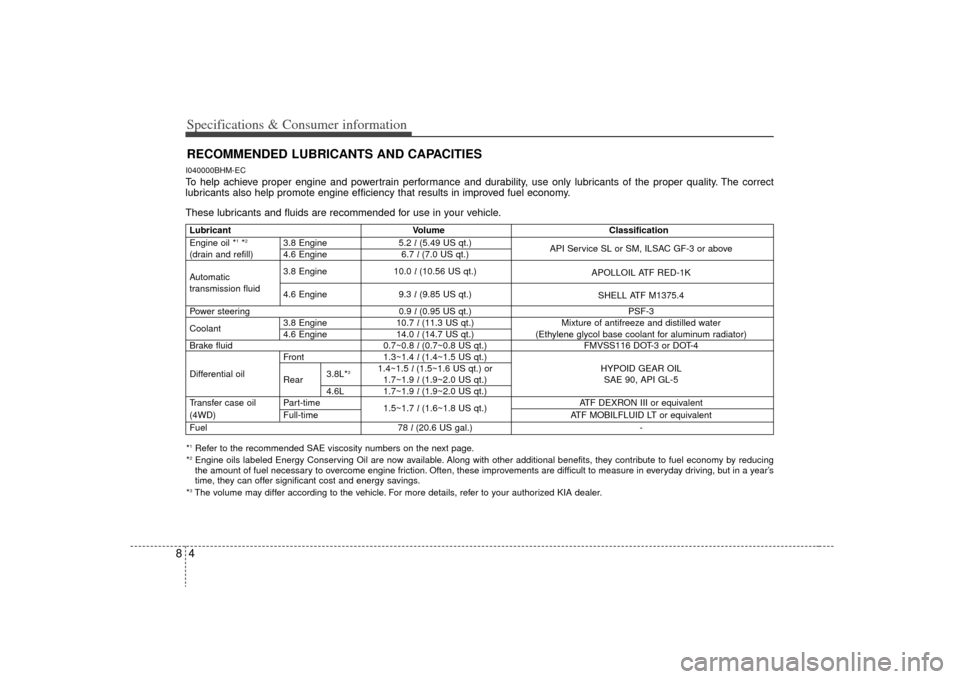
Specifications & Consumer information48RECOMMENDED LUBRICANTS AND CAPACITIESI040000BHM-ECTo help achieve proper engine and powertrain performance and durability, use only lubricants of the proper quality. The correct
lubricants also help promote engine efficiency that results in improved fuel economy.
These lubricants and fluids are recommended for use in your vehicle.*1Refer to the recommended SAE viscosity numbers on the next page.
*2Engine oils labeled Energy Conserving Oil are now available. Along with other additional benefits, they contribute to fuel econo my by reducing
the amount of fuel necessary to overcome engine friction. Often, these improvements are difficult to measure in everyday driving, but in a year’s
time, they can offer significant cost and energy savings.
*3The volume may differ according to the vehicle. For more details, refer to your authorized KIA dealer.Lubricant Volume Classification
Engine oil *
1*2
3.8 Engine 5.2 l(5.49 US qt.)
API Service SL or SM, ILSAC GF-3 or above
(drain and refill) 4.6 Engine 6.7 l (7.0 US qt.)
3.8 Engine 10.0 l (10.56 US qt.)
APOLLOIL ATF RED-1K
Automatic
transmission fluid
4.6 Engine 9.3 l(9.85 US qt.)
SHELL ATF M1375.4
Power steering 0.9 l (0.95 US qt.) PSF-3
Coolant 3.8 Engine
10.7 l (11.3 US qt.) Mixture of antifreeze and distilled water
4.6 Engine 14.0 l (14.7 US qt.) (Ethylene glycol base coolant for aluminum radiator)
Brake fluid 0.7~0.8 l (0.7~0.8 US qt.) FMVSS116 DOT-3 or DOT-4
Differential oil Front
1.3~1.4 l (1.4~1.5 US qt.)
3.8L*
3
1.4~1.5 l (1.5~1.6 US qt.) or HYPOID GEAR OIL
Rear 1.7~1.9 l (1.9~2.0 US qt.) SAE 90, API GL-5
4.6L 1.7~1.9 l (1.9~2.0 US qt.)
Transfer case oil Part-time 1.5~1.7 l (1.6~1.8 US qt.) ATF DEXRON III or equivalent
(4WD) Full-time ATF MOBILFLUID LT or equivalent
Fuel 78 l (20.6 US gal.) -
Page 424 of 425
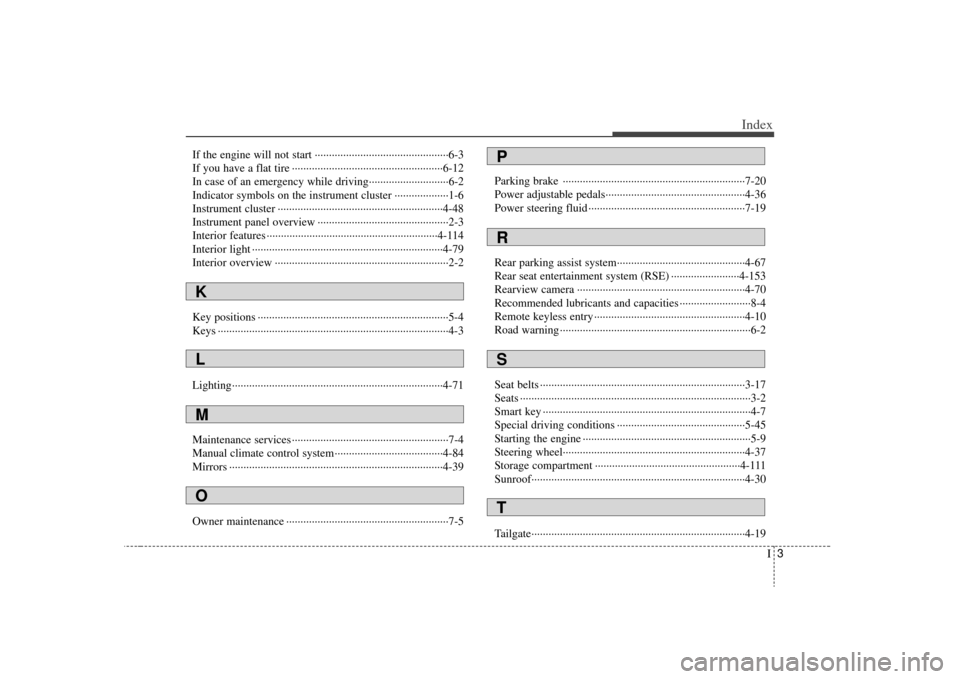
I3
Index
If the engine will not start ··················\
··················\
···········6-3
If you have a flat tire ··················\
··················\
·················6-12\
In case of an emergency while driving··················\
··········6-2
Indicator symbols on the instrument cluster ··················\
·1-6
Instrument cluster ··················\
··················\
··················\
····4-48
Instrument panel overview ··················\
··················\
··········2-3
Interior features ··················\
··················\
··················\
······4-114
Interior light ··················\
··················\
··················\
·············4-79
Interior overview ··················\
··················\
··················\
·······2-2
Key positions ··················\
··················\
··················\
·············5-4
Keys ··················\
··················\
··················\
··················\
·········4-3
Lighting··················\
··················\
··················\
··················\
··4-71
Maintenance services ··················\
··················\
··················\
·7-4
Manual climate control system··················\
··················\
··4-84
Mirrors ··················\
··················\
··················\
··················\
···4-39
Owner maintenance ··················\
··················\
··················\
···7-5Parking brake ··················\
··················\
··················\
··········7-20
Power adjustable pedals··················\
··················\
·············4-36
Power steering fluid ··················\
··················\
··················\
·7-19
Rear parking assist system··················\
··················\
·········4-67
Rear seat entertainment system (RSE) ··················\
······4-153
Rearview camera ··················\
··················\
··················\
·····4-70
Recommended lubricants and capacities ··················\
·······8-4
Remote keyless entry ··················\
··················\
·················4-10\
Road warning ··················\
··················\
··················\
·············6-2
Seat belts ··················\
··················\
··················\
··················\
3-17
Seats ··················\
··················\
··················\
··················\
·········3-2
Smart key ··················\
··················\
··················\
··················\
·4-7
Special driving conditions ··················\
··················\
·········5-45
Starting the engine ··················\
··················\
··················\
·····5-9
Steering wheel···············\
··················\
··················\
·············4-37
Storage compartment ··················\
··················\
···············4-111
Sunroof··················\
··················\
··················\
··················\
···4-30
Tailgate··················\
··················\
··················\
··················\
···4-19KLMO
PRST